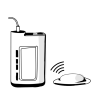Device Combo

Why did you choose a sensor and injections?
I've had type 1 a long time - 48 years. So, during that time as technology has improved, I have used everything from urine droppers and test tubes to CGM, beef/pork NPH to Tresiba, 2 shots per day to an insulin pump. For me personally, some of the more advanced technology did not actually help my glucose control. For example, I wore a pump for about 15 years. It was great for precise dosing and for fine tuning for exercising, high fat meals, etc. However, I hated the tubing; it always got caught on something and it was difficult to conceal in my clothes. More importantly, over the years I had built up so much scar tissue that I had a lot of problems with failed pump infusion sites. So, despite the micro adjustments that only a pump can do, I actually get better net glucose control with injections because the insulin is always delivered. I made the decision to stop the pump at the bottom of the Grand Canyon, where my husband and I had hiked. I was over 400 on the trail and no pump boluses would bring me down. I took an injection (always have back up supplies handy!) and immediately started coming down. It was really a revelation. With my husband's wise urging, I decided no more pump.
I remember getting my first glucose meter when I started college. It was a huge improvement over urine! When CGM became available, I tried early generations but was frustrated with their inaccuracy and the disruption of all the alarms. So, I only wore them occasionally. The new one (FreeStyle Libre) that just became available in the US is highly accurate and does not alarm, so I love it. I wear it 24-7 and miss it during the 12 hours after one sensor expires and the next is warming up. I think the biggest problem that technology has not been able to solve is how to seamlessly integrate all the data and associated recommendations into one easy-to-use device.
What are the trade-offs of using a sensor and injections?
After 48 years, I still hate taking shots. There is still a micro-moment of anxiety before I inject. But, I prefer that to having the pump hanging off me with that tubing. I wish injections allowed me to reduce my basal for exercise the way the pump can. But, at least I'm not spilling ketones frequently, the way I was when I was wearing a pump and had a lot of infusion site failures and clogged tubing.
Diabetes devices can produce a lot of information and numbers. How do you feel about this? What do you do with all the data?
I think this is more of a problem for CGMs that alarm, because the patient is provided unsolicited data. With the Libre CGM system, there is no alarm, so the data only becomes available when the patient seeks it out.

These are my devices.
How do you respond to people when they notice or comment on your devices?
Just today in yoga, someone saw the CGM sensor on my arm and asked me if I was wearing a pain patch. I did not want to provide a detailed explanation because we were in the middle of class holding a pose! So I just said, "no, it's something else" and then after class I told her what it was. The other day I was meditating and was asked to put my phone away. I explained that it was a medical device, not a phone.
It doesn't really bother me. People are curious and uninformed. I don't hold it against them - I'm uninformed about a lot of things myself! I try to be positive and patient and provide as much information as they seem to want until it starts to feel too personal. It helps to raise consciousness about living with diabetes, so that there is more understanding and compassion in the world.
How do you make the devices comfortable on your body?
Well, I quit wearing my pump because it never became comfortable. When I stopped wearing it, my irritability - which I had assumed was just part of my personality - kind of vanished. I suddenly realized how bothersome the pump had been all those years.
The CGM is not uncomfortable at all.
I carry all my diabetes supplies in a zippered pouch with an embroidered, paisley pink elephant on it. Before that, I had a zippered pouch with birds and berries all over it. I always keep my supplies in a cheerful container - nothing serious or techy looking - so that each self-care behavior I do somehow feels less medicalized.
What helps you trust your devices?
Experience is the only thing that counts for me. I have to use something and see how it works to trust it. Of course, recommendations from friends with diabetes and doctors will get me to try something in the first place. But to keep using it, I have to use it and judge for myself.
What would you tell someone considering this same combo and deciding if it is worth the money?
Injections are cheap, so there's no convincing needed. CGM is more expensive, so that's a real consideration especially if insurance does not cover it. Diabetes self-care is not a one-size fits all. I would encourage them see if they could try a CGM for a week by borrowing it from their endocrinologist's office.
What challenges do you have and how have you overcome them?
My main challenge is that my doctor always wants to put me on the latest thing - new insulins, other injectables, new CGM. I hate technology and have a lot of inertia, so never want to try new things. We compromise. I tell her I will try them for a period of time, but always reserve the right to go back to my old regimen.
I travel a lot- and often to the developing world where the medical care is poor and support for technology very limited. So, I always carry tons of back-up supplies - some in a carry-on, some in checked luggage, and some with my husband's luggage, too. I also carry a medical letter from my doctor explaining what everything is that I'm carrying.







